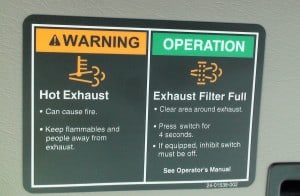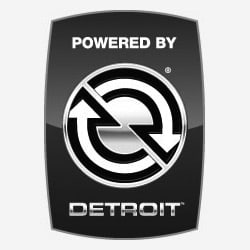DPF Lights | What to Look for When They Come On
New technologies are dramatically changing the way heavy duty trucks are engineered. They’re more efficient, more comfortable and far more convenient to drive. In many ways, they’re easier and less costly to maintain. But driving and maintenance require a new set of skills that correspond to all that new technology. If your truck is equipped with a diesel particulate filter, how do you know what to look for when the DPF lights come on?

The DPF traps exhaust particulates. It’s not a disposable item – a new one can cost around $3000 — so it has to be cleaned periodically to maintain top emissions reduction performance and fuel efficiency. DPF warning lights might be solid or flashing when they come on, indicating two different concern levels. And there are two ways to regenerate an engine. Let’s walk through it.
The DPF status light is on steadily.
This is your first warning that your engine may need regeneration. You probably have several more hours to operate the truck before the engine starts to de-rate. You can perform an automatic, or passive, regeneration by driving your truck at an uninterrupted highway speed.
As you’re running, sensors reach the exhaust back pressure and automatically inject extra fuel to increase the temperature in your DPF, burning off accumulated soot. Or your truck may be equipped with an integrated oxidizing catalytic converter which accomplishes the same thing.
The DPF status light is flashing.
This is your second warning, and it’s more urgent. It’s telling you a parked regeneration is necessary, and you need to perform it as soon as possible. If your Check Engine light comes on while the DPF status light is flashing, it means you need to perform a parked regen right away. You may also hear a beeping sound to further alert you.
Here’s what you should do:
- Park your truck. Pull it well off the highway – not in a grassy area or where there are flammable or combustible materials nearby.
- Display the special hangtag that says “Caution – parked – DPF regeneration in progress.”
- Put your transmission in neutral.
- Apply your parking brake.
- Release the parking brake and then re-apply it.
- Press and release the clutch pedal, if you have one.
- Push the REGEN button on your dashboard and hold it for a moment.

The regeneration process takes anywhere from 20 to 40 minutes to complete. During that time your engine RPM will increase, but it will return to normal when regen is done. You may also see the High Exhaust System Temperature (HEST) light, which simply means what the name indicates. The light should go out when regeneration is complete.
The Stop Engine light is your last chance.
If you don’t perform the required regeneration as needed, your DPF will become clogged, which will damage your engine. If you see this light, shut down your rig immediately and call for roadside assistance.
Your sun visor has a decal that explains the steps for a parked regeneration, so you always have the information with you.
Eventually, you’ll have to remove and clean your DPF.
It’s made of ceramic material, which is very durable, and if you’re following your OEM’s recommended regeneration procedures, the filter will work well for a long time. But ultimately it will need manual cleaning. Industry averages are about 300,000 miles for trucks manufactured between 2007 and 2009, up to 400,000 miles for newer trucks.
